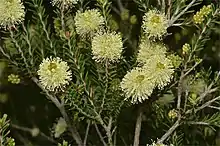| Yellow paperbark | |
|---|---|
 | |
| Melaleuca pustulata in The Tasmanian Arboretum | |
| Scientific classification | |
| Kingdom: | Plantae |
| Clade: | Tracheophytes |
| Clade: | Angiosperms |
| Clade: | Eudicots |
| Clade: | Rosids |
| Order: | Myrtales |
| Family: | Myrtaceae |
| Genus: | Melaleuca |
| Species: | M. pustulata |
| Binomial name | |
| Melaleuca pustulata | |
| Synonyms[1] | |
|
Myrtoleucodendron pustulatum (Hook.f.) Kuntze | |
Melaleuca pustulata, commonly known as yellow paperbark, warty paperbark or Cranbrook paperbark is a plant in the myrtle family, Myrtaceae and is endemic to Tasmania in Australia. It is an uncommon shrub, one of only two melaleucas that are endemic to that state and one of only eight found naturally occurring there. It has thick, pimply leaves, hairy new growth and large numbers of heads of pale yellow, fragrant flowers in spring or early summer.
Description
Melaleuca pustulata is a densely foliaged shrub, growing to 5 m (20 ft) tall with hairy new growth. Its leaves are arranged alternately, sometimes in groups of three and are 5–10 mm (0.2–0.4 in) long, 0.5–1.6 mm (0.02–0.06 in) wide, very narrow elliptic to very narrow egg-shaped, roughly semi-circular in cross section and with the ends tapering to a point. The mature leaves have distinct raised oil glands giving the leaves a blistered appearance.[2][3]
The flowers are white to yellowish, scented and arranged in spikes or heads on the ends of branches that continue to grow after flowering. The heads are up to 18 mm (0.7 in) in diameter and contain 15 to 30 individual flowers. The petals are 2 mm (0.08 in) long and fall off as the flower matures. There are five bundles of stamens around the flower, each with 5 to 9 stamens. Flowering occurs from September to January and is followed by fruit that are woody, cup-shaped capsules, 3–5 mm (0.1–0.2 in) long in cylindrical clusters along the stem.[2][3]
Melaleuca pustulata is sometimes confused with Melaleuca ericifolia, which also occurs naturally in Tasmania; however, the leaves of that species lack the raised oil glands of M. pustulata and the outer surface of its flower cup (hypanthium) is hairy.[2]
Taxonomy and naming
Melaleuca pustulata was first formally described in 1847 by Joseph Hooker from specimens collected "in Campbell Town and Oyster Bay".[4][5]
'Melaleuca' is derived from Greek and means 'black and white', a reference to the color of the bark.[6]
The specific epithet (pustulata) is derived from the Latin word pustula meaning "pimple", "blister" or "bubble",[7] referring to the prominent oil glands on the leaves of this species.[2]
Distribution and habitat
This melaleuca occurs near the east coast of Tasmania usually in dry heath, often on shallow soils derived from dolerite.[2][3][8][9]
Conservation status
Melaleuca pustulata is declared a rare species under the Tasmanian Government Threatened Species Protection Act 1995.[10][11]
Use in horticulture
Melaleuca pustulata is a useful plant for hedges and windbreaks.[3]
References
- 1 2 "Melaleuca pustulata". Plants of the World Online. Retrieved 5 September 2021.
- 1 2 3 4 5 Brophy, Joseph J.; Craven, Lyndley A.; Doran, John C. (2013). Melaleucas : their botany, essential oils and uses. Canberra: Australian Centre for International Agricultural Research. p. 298. ISBN 9781922137517.
- 1 2 3 4 Holliday, Ivan (2004). Melaleucas : a field and garden guide (2nd ed.). Frenchs Forest, N.S.W.: Reed New Holland Publishers. pp. 234–235. ISBN 1876334983.
- ↑ Hooker, Joseph Dalton (1847). "Florae Tasmaniae Spicilegium: or, Contributions towards a Flora of Van Diemen's Land". London Journal of Botany. 6: 476–477. Retrieved 7 June 2015.
- ↑ "Melaleuca pustulata". APNI. Retrieved 23 July 2015.
- ↑ Gledhill, David (2008). "The Names of Plants". Cambridge University Press. ISBN 9780521866453 (hardback), ISBN 9780521685535 (paperback). pp 254
- ↑ Brown, Roland Wilbur (1956). The Composition of Scientific Words. Washington, D.C.: Smithsonian Institution Press. p. 118.
- ↑ "Melaleuca pustulata scrub" (PDF). Tasmanian government forest practices authority. Retrieved 7 June 2015.
- ↑ Jordan, Greg. "Melaleuca pustulata". University of Tasmania. Retrieved 7 June 2015.
- ↑ "Melaleuca pustulata". Tasmanian government Department of Primary Industries, Water and Environment. Retrieved 31 March 2020.
- ↑ "Melaleuca pustulata" (PDF). Tasmanian Government Department of Primary Industries, Parks, Water and Environment. Retrieved 7 June 2015.